
David Harvey
 |
Historic Lotus Register | Lotus Mk VII David Harvey |
|---|
To send e-mail click on name above
The car that started to be built as the Lotus Mark VII and was turned into the Clairmonte Special is now owned by HLR member David Harvey who rebuilt it with the late Peter Ross. There is a wealth of information on the history of the car.
David also owns the Lotus Mk III replica LMU5 which started life as John Teychenne's Austin Seven Special the JVT-1 in 1952.
| Lotus Mark VII |
|---|
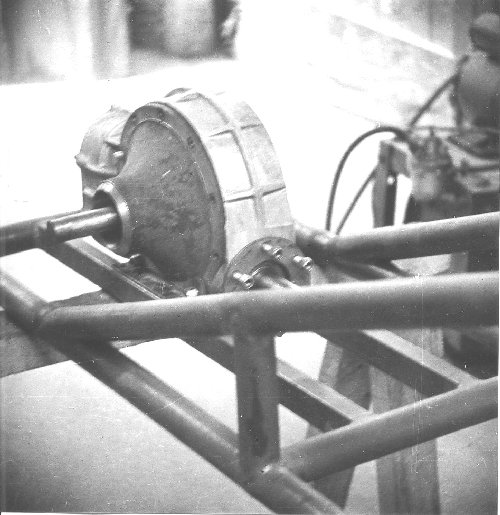 |
| The Lotus Mk VII single seat Formula 2 car under construction at the Lotus Works at Hornsey in 1952, showing the Halibrand Final Drive Unit in position. Photo by Michael Allen |
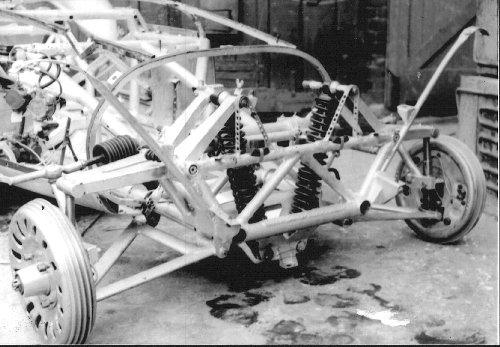 |
| The Clairmonte Special nearing completion at Clairmonte's Shanklin Road factory, but before the Lea-Francis 1.5 litre engine was fitted. The inboard springs for the wishbone front suspension may be clearly seen. Photo courtesy of Zoe Calvert |
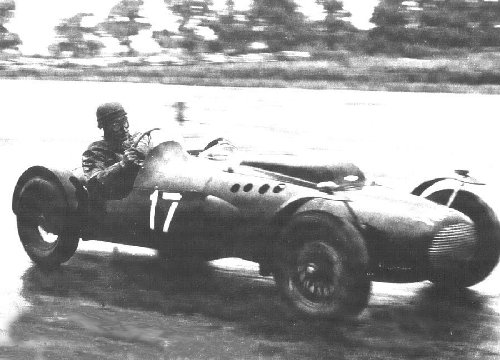 |
| The Clairmonte Special as it first appeared in 1953 with 1.5 litre Lea-Francis engine. Photo courtesy of Ferret Photographics |
There is a good account of the history of this car in HISTORIC LOTUS No. 40 Winter 2004. For greater detail look at this website.
The story is covered in the greatest depth in the book "Lotus - The Early Years" published by Coterie Press.
| Brief history: The forgotten Lotus |
|---|
The first Lotus single seat racing car was designed by Colin Chapman during the winter of 1951/52 to the order of Clive Clairmonte. Following closely after the design of the Lotus Mark VI, it was given the name Lotus Mark VII. It should not be confused with the Lotus Seven (successor to the Mk VI) which used the same number but did not appear until 1957.
John Teychenne joined the newly formed Lotus Engineering Company in February 1952 to build this car (he had helped get the order from Clairmonte) and work soon started on the front suspension, and then the chassis frame itself.
The deal was that Lotus would supply a rolling chassis, and Clairmonte would supply the Riley 6 cylinder 2 litre engine and gearbox (from the ex-Hector Dobbs Riley he had been racing in 1951), and the Halibrand Final Drive Unit, with delivery in time for it to be raced in Formula 2 events before the end of the 1952 season.
The design included several very advanced features, many not to be seen again on a Lotus for several years:
Space frame with correctly sized tubes. (Works Lotus Mk 8 1954)
De Dion rear suspension with inboard rear brakes. (Lotus Mk 8 1954)
Rack and Pinion Steering (Works Lotus Mk 9 1955)
Wishbone front suspension (Lotus 12 1957)
Cantilever upper wishbones with inboard springs (Lotus 21 1961)
Work on the car progressed very slowly as all their effort was being put into producing the prototype Mark 6 with Ford Consul engine, and money ran out to pay John Teychenne so he had to get another job and carry on in the evenings and at weekends.
In about September 1952 Clive Clairmonte lost patience and collected the partly finished car (chassis frame, front suspension with brakes, Final Drive Unit and engine mountings in position), to complete it himself in his factory in Shanklin Road, Crouch End, less than a mile from the Lotus works at Tottenham Lane Hornsey, using his mechanic Fred "Sorrento" Boon.
He experienced an expensive engine failure with the engine in the Hector Dobbs 6 cylinder 2 litre Riley he had been racing in 1951/52, and which he had intended to use in his new car. This, plus the fact that the Formula had only one more year to run, must have caused Clairmonte to abandon the idea of having a single seater, and he decided to convert it into a 1.5 litre sports car instead.
Sorrento (so named because if his obsession with all things Italian) worked hard to widen the frame, complete the rear suspension, fit the new 1.5 litre Lea-Francis engine and gearbox, and get it ready for Williams & Pritchard to create the distinctive shaped body which you can see in the photograph.
It raced with some success in 1953, and in 1954 was fitted with a 2 litre Connaught engine and raced in the 2 litre class, mixing it with Archie Scott Brown in the Lister, and (in 1955) with Mike Anthony in the Lotus Mk X.
Clairmonte and Chapman became locked in a legal battle for compensation, which is why Clairmonte decided to call it by another name, and Chapman (not wishing to be reminded of his lost opportunity) disowned it completely, and five years later used the name on the successor to the Mark 6
Over the years the body became damaged and replaced with shapes quite unlike the original, and this is why it has this year been shown without body so that details of the very advanced chassis design may be clearly seen.
The owners, David Harvey and Peter Ross, intend to restore it as a 2 litre sports car for racing in Historic Sports Car races for cars with drum brakes. A replica chassis will be made, a Riley 2 litre engine and gearbox obtained, and faithful copies of the suspension made so that the world may see an exact replica of the original Lotus Mark VII as designed by Colin Chapman in 1951.
| Restoration Progress |
|---|
The engine and gearbox have been removed and taken to Beaufort Restoration at Sittingbourne in Kent for overhaul under the watchful eye of proprietor Mike Williams. They have already discovered that the engine is not pure Connaught, but appears to have a Turner crankcase!
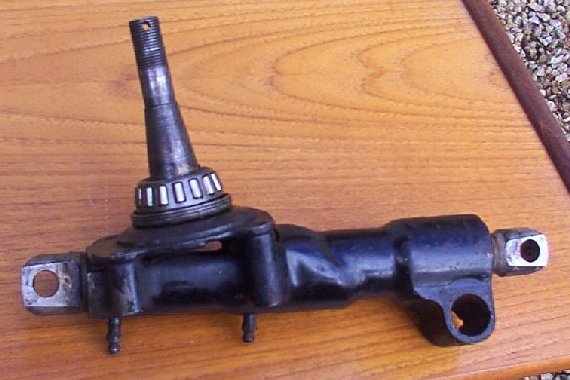 |
| Puzzle - How to identfy the front suspension upright! |
Solving this was indeed a puzzle. I wrote to everyone I could think of to try to identify the car from which the upright had come, with total lack of success. I then chanced to look at the photograph of the Clairmonte being worked on in Clive Clairmonte's factory (see below) and there was something about the upright which looked at odds with the part I had taken off the Clairmonte..
 |
For a start it didn't look anything like the one I was trying to identify, and had a very slender diameter at the upper end. Closer examination was difficult due to the rather poor focus, but it became obvious that the steering arm was attached at a point near to the front axle spindle and consisted of a tube which was angled upwards to meet the outer end of the rack and pinion track rod, to allow the track rod to be in line with the upper wishbone for aerodynamic reasons.
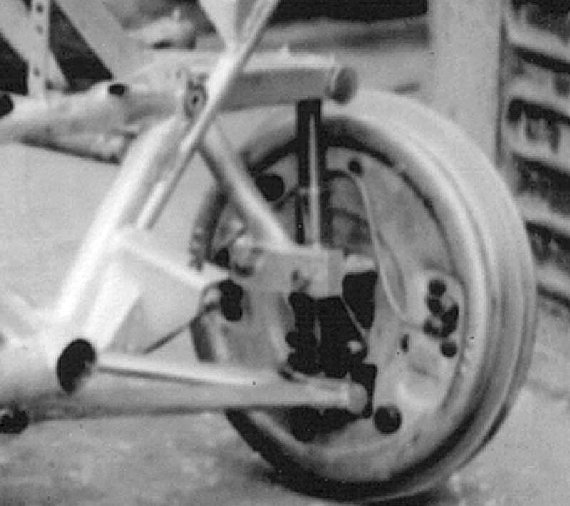 |
So it looked as though Chapman had not been responsible for the design of the upright that I had taken off the Clairmonte.
Another little bit of information was then revealed. In 1953 the Clairmonte was taken to Goodwood. Clive's nephew Sebastian was there and he tells me that the Scrutineers failed the front suspension and would not let it race! Clairmonte vowed never to race there again, but for 1954 he modified the upright by encasing it in the black tube which I was trying to identify. He left the original upright unchanged, but it was now INSIDE a tube, and the steering arm was now a part from a TD MG, with part of the TD MG upright welded to the new upright at the top, instead of slanting up from the middle.
This caused me to look again at my upright, and I now realise that the whole thing is a fabrication, with the welds meticulously filed down to make it look like a casting/forging!
The next thing that happened was I went to the 2005 Goodwood Revival and had a good look at the 500 racers. To my amazement many of them also used a Ford Ten Stub Axle with extended King Pin just like the original Lotus Mk VII design.. I talked to one of the mechanics who was about my age and thus around at the time, and he told me that most of the home built 500s at that time used the Ford Ten Stub Axle in this way. Here is a picture of the Kieft 500 which shows how the Ford Ten stub axle was used.
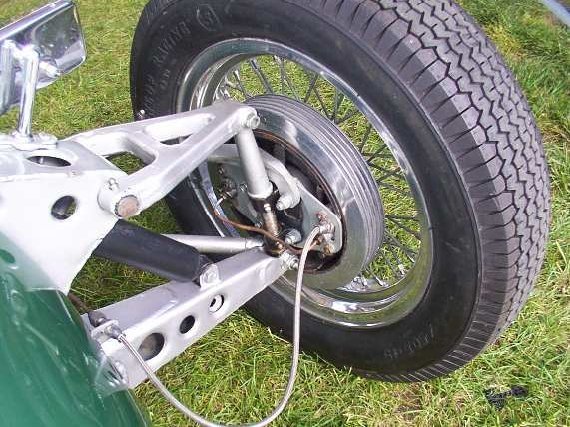 |
I think Colin got the idea from the 500 chaps. He was good at picking up bright ideas, and this must have seemed a good one as he already knew about Ford Ten hubs. All he had to do was create something to bolt onto the Stub Axle to connect it to the Rack & Pinion track rod, and I think it is this which the scrutineers disliked.
So I will not be copying Clive's heavy modification for the Mk VII replica, which must have added a large chunk of unsprung weight (which would have been anathema to Colin) but instead will try to produce a slightly stronger version of what he designed.